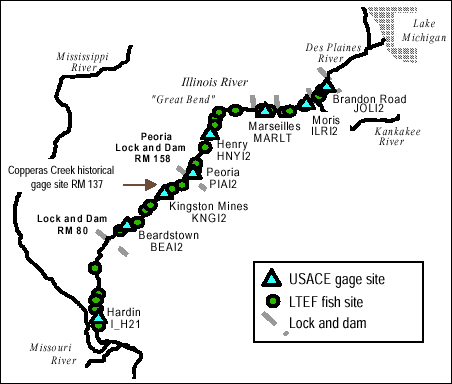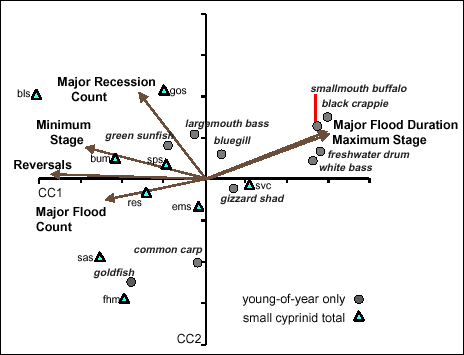|
PSR 2000-03 May 2000 Abundance of Age-0 Fishes Correlated with Hydrologic Indicatorsby Todd M. Koel1 |
||
|
The dynamic hydrological characteristics of large river systems are considered the principal factors that regulate riverine productivity. The Upper Mississippi River System (UMRS), which has been leveed and impounded, should be managed based on the understanding of relations among physical and biological systems and the way that human activities have affected these relations. An understanding of how hydrology and biotic processes interact is required before the ecological or social values resulting from alternative water management scenarios can be evaluated. The primary objective of this study is to relate interannual variability of a long-term fisheries data set with ecologically meaningful hydrological parameters quantified by the Indicators of Hydrologic Alteration (IHA) computer program. 2 Daily river surface elevations during 1957-1998 were obtained from the U.S. Army Corps of Engineers for eight gage sites along the Illinois River (Figure 1). The IHA program was used to compute 42 hydrologic parameters for each gage site for each year. Parameters were grouped into five categories: water level minima and magnitudes, timing, frequency, and duration of recession and flood events (defined by the 25th and 75th percentile of the long term water level record, respectively), and rates of change of water levels. These parameters were calculated as means for the entire calender year and also for restricted seasons of interest, including spring (May and June) and winter (December and January). |
||
|
||
|
Fish communities of the Illinois River were monitored as a part of the Long-term Illinois River Fish Population Monitoring Program (LTEF) from 1957 to the present. Fishes were sampled by electrofishing at 26 sites annually (Figure 1). Most sites were located in side channel habitats and were sampled from late August to early September when river levels were low and stable. Yearly abundance of age-0 fishes for 10 species, which had adequate LTEF data, were estimated as catch-per-unit-effort. Maximum lengths of age-0 fish were determined from the published literature for this region and growth data for the Illinois River. The total catches of several small cyprinids (minnows) were also included in the analysis. Most of these species are multiple spawners and are capable of increasing population levels quickly during years when conditions are optimal. Canonical correspondence analysis (CCA) was then used to relate hydrological characteristics of river reaches to annual fish abundances. Gradients explaining the greatest amount of variation in the fish data set were numbers of reversals in river stage (changes from rise to fall, or fall to rise), maximum stage levels, and high pulse duration (Figure 2). Major flood and recession counts and minimum river stage were also important, but to a lesser extent. Age-0 smallmouth buffalo Ictiobus bubalus, black crappie Pomoxis nigromaculatus, freshwater drum Aplodinotus grunniens, and white bass Morone chrysops were correlated with above average major flood durations and maximum stage, and with below average numbers of reversals, major flood counts, and minimum stage. Abundances of age-0 fishes of these native species were greater during years characterized by a high, smooth, spring flood pulse. Age-0 gizzard shad Dorosoma cepedianum and bluegill Lepomis macrochirus (and to a lesser extent, largemouth bass Micropterus salmoides and green sunfish Lepomis cyanellus), correlated with near average flood duration and maximum stage, and near average levels of stage reversals. Non-native species such as age-0 common carp Cyprinus carpio and goldfish Carassius auratus correlated with below average levels of high pulse duration and maximum stage and above average levels of stage variability (reversals, and flood or recession counts). Interestingly, these non-native fishes appear to have benefitted from the unnatural variability of this system. |
||
|
||
|
Results of this study are entirely exploratory and should be considered preliminary until validation of the CCA model predictions are made with data from other systems. Tools are needed to predict the responses of fisheries, nuisance species, and endangered species to hydrologic manipulation. Improved understanding of relations among aquatic biota and the geomor-phological, hydrological, and chemical characteristics of rivers will be crucial for evaluating management options in the future. If naturalization of the UMRS is a desired goal, future research should continue to include the evaluation of different hydrological regimes with respect to responses of the riverine biota and floodplain landscape. Restoring hydrologic features that approximate the natural flow regime may benefit many native, large-river species in the system. 1Minnesota Department of Natural Resources,
Lake City, Minnesota |
||
|
This report is a product of the Long Term Resource Monitoring Program for the Upper Mississippi River System. For further information, contact U.S. Geological Survey Project Status Reports (PSRs) are preliminary documents whose purpose is to provide information on scientific activities. Because PSRs are only subject to internal peer review, they may not be cited. Use of trade names does not imply U.S. Government endorsement of commercial products. All Project Status Reports are accessible through the Upper Midwest Environmental Sciences Center’s website at http://umesc.usgs.gov/reports_publications/psrs/umesc_psr.html |
Page Last Modified: April 17, 2018



